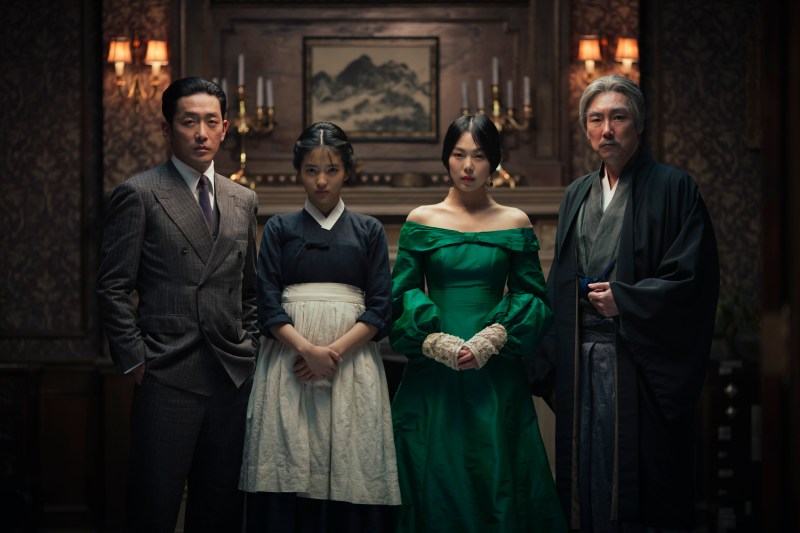Director Park Chan-wook provides us with another sumptuous feast of revenge and counter-revenge with “The Handmaiden” (now playing at Palo Alto’s Aquarius Theatre for the next week). This time, he takes a fresh approach by creating a love tale between two female protagonists and dialing back his usual schtick of gratuitous bloodshed. (Looking at you, “Oldboy.”)
Taking place in Japanese-occupied Korea in the 1930s, the film opens with the young Sook-Hee plotting with a low-born swindler posing as a rather grand “Count Fujiwara.” Their mission: to romance a Japanese heiress, throw her in an asylum and strip her of her fortune. The plot thickens, however, when the romancing of Lady Hideko is not done by the Count, but Sook-Hee herself, as Hideko’s handmaiden.
“The Handmaiden” is clever, all very clever. Layers of secrecy slide open and shut like the shoji screens of the movie’s Victorian-Japanese crossover mansion, an impossible large yet claustrophobic item. We’re forced to pore over every character’s move and intent. After all, according to the Count, “it’s illegal to be naïve.” The film accomplishes most of this with clever inversions in language, in plot and in multiple-person perspectives. At the start of Part II, the movie starts to trip over its own feet, giving us a clumsy relay of a “behind-the-scenes” of Part I, then a lengthy torture scene that lacks any nuance and purpose for Part III. The end, too, leaves us with an explicit bang. Not one that knocks you off your feet, but your senses. You leave the theatre asking, “Was all that flesh necessary to convey the message?”
Here’s the tricky part: As much as “Handmaiden” is about female empowerment and critiquing the sexualization of women, it still stumbles with its depiction of women. Hideko, for example, is the flattest character in the movie; she’s as feeble and helpless near the end as she is in the beginning, when she stiltedly moves like a dolled-up Victorian apparition. All the machinations are Sook-Hee’s or the Count’s own, and Hideko follows. The film also chides the male gaze, as Hideko, ordered by her perverted uncle, recites erotica in front of a cohort of gentlemen, each fantasizing about her under their tightening tuxedos. But when the camera revisits a female-on-female action from Part I in more explicit terms for Part II, not even the ongoing witty dialogue relieves the hypocrisy.
The film succeeds, however, in giving us a penetrating look on cultural imperialism and how language shapes power dynamics. Perhaps not as obvious to Western audiences, the movie is a messy amalgam of culture. The lady of the house, Hideko, slips in and out of a kimono from a Victorian petticoat, while the maids parade around in hanbok, a traditional Korean costume. Here we have an antagonist – Hideko’s uncle, Kouzuki – who has adopted the Japanese way of life (though Korean) and who dismisses Korea as “ugly” while extolling Japan as “beautiful.”
The uncle, for one, is acutely aware of the fact that appropriating cultures in power lends him a similar power. For instance — take the house where much of “Handmaiden” is set. Kouzuki’s own incoherent design borrows from the cultures of two imperialist powers, Japan and England. It’s his own insecurity as a commoner, combined with his colonized mind, that builds the rigid framework of cultural hierarchy in the household. Similarly, the child Hideko must learn Korean to interpret verbal abuse from the housekeeper or the gossip of the maids; Sook-Hee’s illiteracy in Japanese is taken advantage of as others lay traps for her in plain sight.
As much as characters strive to get the upper hand over others, sometimes power is re-appropriated by means of language. Hideko often borrows phrases from characters plotting against her to surprise and distract them. When Sook-Hee busies herself twirling around in Hideko’s jewels, Hideko catches her off guard by telling Sook-Hee, much to her surprise, that “yours is the face I think about before I go to sleep at night.” It’s something Sook-Hee told her the Count said, many scenes ago. And afterwards, Sook-Hee lifts her eyes from her reflection in the mirror to the creeping blush on Hideko’s face, finding another –perhaps truer – reflection there.
Contact Elaine Kim at elainekm ‘at’ stanford.edu.
